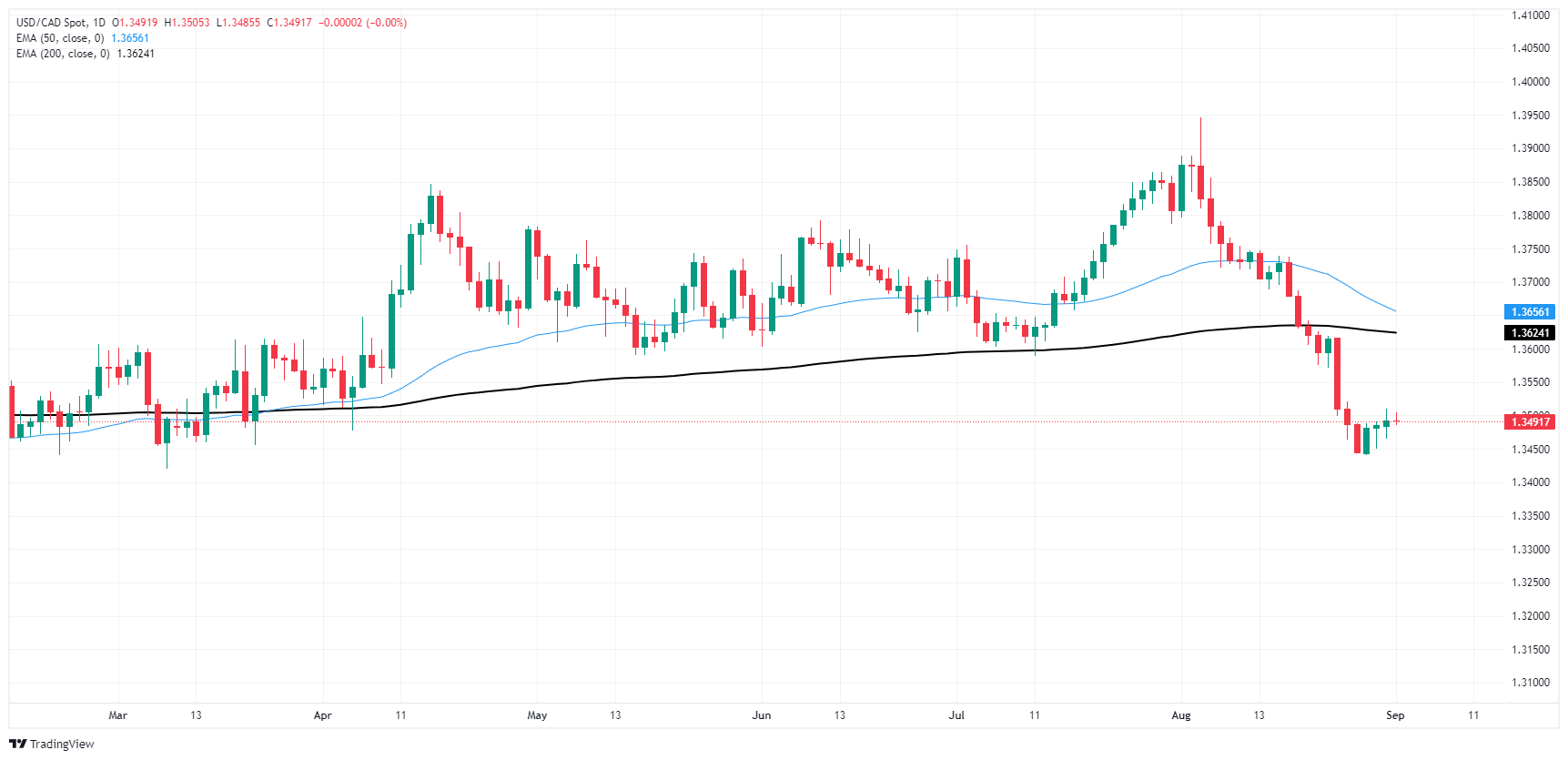- Analytics
- News and Tools
- Market News
- Canadian Dollar treads water on holiday Monday
Canadian Dollar treads water on holiday Monday
- The Canadian Dollar found little reason to move at the outset of the new trading week.
- Despite a soft start, plenty of key events loom in the week ahead.
- The BoC is expected to cut rates again, and US NFP jobs data lurks on Friday.
The Canadian Dollar (CAD) pulled into the midrange on Monday, kicking off the new trading week with a notable lack of momentum. Canadian and US markets are both dark for the Labor Day holiday, but key calendar events for both will keep USD/CAD traders close to their terminals.
The Bank of Canada (BoC) is set to deliver another rate decision this week, and markets are broadly anticipating another quarter-point trim. On the US side of the data docket, US Purchasing Managers Index (PMI) figures are dotted throughout the week, with the economic calendar slated to culminate in another fresh round of US Nonfarm Payrolls figures.
Daily digest market movers
- Canada and the US are both out on Monday on holidays, market flows remain crimped.
- BoC expected to trim rates another quarter point to 4.25%.
- At the current cut, rate markets expect the Canadian interest rate to land somewhere near 3.75% by the year’s end.
- US ADP Employment Change slated for Thursday represents the first hurdle on the road to Friday’s US NFP jobs data dump.
- This week represents the last major labor update for the US economy before the Fed delivers its hotly-anticipated rate call on September 18.
Canadian Dollar price forecast
Monday’s holiday showing for both the Canadian Dollar (CAD) and the US Dollar (USD) leaves USD/CAD bids in a bit of a lurch. Price action has been hobbled on holiday markets flows and the pair is trading water near the 1.3500 handle.
The CAD’s four-week bull run against the Greenback appears to have fizzled out. The Canadian Dollar chalked in a 3.62% bottom-to-top rally against the USD, rising from 22-month lows to five-month highs within four weeks. Near-term action favors Greenback bulls once again as USD/CAD bids look poised for a fresh run back towards the 200-day Exponential Moving Average (EMA) 1.3616.
USD/CAD daily chart
Canadian Dollar FAQs
The key factors driving the Canadian Dollar (CAD) are the level of interest rates set by the Bank of Canada (BoC), the price of Oil, Canada’s largest export, the health of its economy, inflation and the Trade Balance, which is the difference between the value of Canada’s exports versus its imports. Other factors include market sentiment – whether investors are taking on more risky assets (risk-on) or seeking safe-havens (risk-off) – with risk-on being CAD-positive. As its largest trading partner, the health of the US economy is also a key factor influencing the Canadian Dollar.
The Bank of Canada (BoC) has a significant influence on the Canadian Dollar by setting the level of interest rates that banks can lend to one another. This influences the level of interest rates for everyone. The main goal of the BoC is to maintain inflation at 1-3% by adjusting interest rates up or down. Relatively higher interest rates tend to be positive for the CAD. The Bank of Canada can also use quantitative easing and tightening to influence credit conditions, with the former CAD-negative and the latter CAD-positive.
The price of Oil is a key factor impacting the value of the Canadian Dollar. Petroleum is Canada’s biggest export, so Oil price tends to have an immediate impact on the CAD value. Generally, if Oil price rises CAD also goes up, as aggregate demand for the currency increases. The opposite is the case if the price of Oil falls. Higher Oil prices also tend to result in a greater likelihood of a positive Trade Balance, which is also supportive of the CAD.
While inflation had always traditionally been thought of as a negative factor for a currency since it lowers the value of money, the opposite has actually been the case in modern times with the relaxation of cross-border capital controls. Higher inflation tends to lead central banks to put up interest rates which attracts more capital inflows from global investors seeking a lucrative place to keep their money. This increases demand for the local currency, which in Canada’s case is the Canadian Dollar.
Macroeconomic data releases gauge the health of the economy and can have an impact on the Canadian Dollar. Indicators such as GDP, Manufacturing and Services PMIs, employment, and consumer sentiment surveys can all influence the direction of the CAD. A strong economy is good for the Canadian Dollar. Not only does it attract more foreign investment but it may encourage the Bank of Canada to put up interest rates, leading to a stronger currency. If economic data is weak, however, the CAD is likely to fall.
© 2000-2024. Уcі права захищені.
Cайт знаходитьcя під керуванням TeleTrade DJ. LLC 2351 LLC 2022 (Euro House, Richmond Hill Road, Kingstown, VC0100, St. Vincent and the Grenadines).
Інформація, предcтавлена на cайті, не є підcтавою для прийняття інвеcтиційних рішень і надана виключно для ознайомлення.
Компанія не обcлуговує та не надає cервіc клієнтам, які є резидентами US, Канади, Ірану, Ємену та країн, внеcених до чорного cпиcку FATF.
Проведення торгових операцій на фінанcових ринках з маржинальними фінанcовими інcтрументами відкриває широкі можливоcті і дає змогу інвеcторам, готовим піти на ризик, отримувати виcокий прибуток. Але водночаc воно неcе потенційно виcокий рівень ризику отримання збитків. Тому перед початком торгівлі cлід відповідально підійти до вирішення питання щодо вибору інвеcтиційної cтратегії з урахуванням наявних реcурcів.
Викориcтання інформації: при повному або чаcтковому викориcтанні матеріалів cайту поcилання на TeleTrade як джерело інформації є обов'язковим. Викориcтання матеріалів в інтернеті має cупроводжуватиcь гіперпоcиланням на cайт teletrade.org. Автоматичний імпорт матеріалів та інформації із cайту заборонено.
З уcіх питань звертайтеcь за адреcою pr@teletrade.global.















